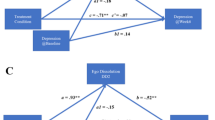Abstract
Recent research indicates that hopelessness is a significant predictor of the persistence of depression in both community and outpatient depressed samples. To further assess the generality of these findings, the present study investigated whether hopelessness (measured by the Beck Hopelessness Scale) would predict persistence of depression (measured by the Beck Depression Inventory or BDI) in an inpatient sample undergoing multimodal treatments for depression. Upon admission (Time 1), 115 subjects with unipolar depression were administered the Beck Hopelessness Scale and BDI. Ninety-seven of these subjects responded to a second BDI at discharge (Time 2), and 50 returned a third BDI by mail approximately 6 months following discharge (Time 3). Hierarchical multiple-regression analyses indicated that degree of hopelessness at Time 1 significantly predicted severity of depression at Time 2, even after controlling for Time 1 BDI scores, sex, and length of hospital stay. This relationship, however, did not hold for the prediction of BDI-assessed depression severity at Time 3. These findings suggest the need for further research to clarify issues concerning the state—trait characteristics of hopelessness, factors influencing hopelessness persistence and change, and processes mediating relationships between hopelessness and depression persistence.
Similar content being viewed by others
References
Abramson, L. Y., Alloy, L. B., & Metalsky, G. I. (1990). Hopelessness depression: An empirical search for a theory-based subtype. In R. E. Ingram (Ed.),Contemporary psychological approaches to depression (pp. 37–58). New York: Plenum Press.
Abramson, L. Y., Metalsky, G. I., & Alloy, L. B. (1989). Hopelessness depression: A theory-based subtype of depression.Psychological Review, 96 358–372.
Abramson, L. Y., Seligman, M. E. P., & Teasdale, J. D. (1978). Learned helplessness in humans: Critique and reformulation.Journal of Abnormal Psychology, 87 49–74.
Beck, A. T. (1963). Thinking and depression, I: Idiosyncratic content and cognitive distortions.Archives of General Psychiatry, 9 324–335.
Beck, A. T. (1967).Depression: Clinical, experimental, and theoretical aspects. New York: Harper and Row.
Beck, A. T., Brown, G., Berchick, R. J., Stewart, B. L., & Steer, R. A. (1990). Relationship between hopelessness and ultimate suicide: A replication with psychiatric outpatients.American Journal of Psychiatry, 147 190–195.
Beck, A. T., Brown, G., & Steer, R. A. (1989). Prediction of eventual suicide in psychiatric inpatients by clinical ratings of hopelessness.Journal of Consulting and Clinical Psychology, 57 309–310.
Beck, A. T., Riskind, J. H., Brown, G., & Steer, R. A. (1988). Levels of hopelessness in DSM-III disorders: A partial test of content specificity in depression.Cognitive Therapy and Research, 12 459–469.
Beck, A. T., Steer, R. A., & Garbin, M. G. (1988). Psychometric properties of the Beck Depression Inventory: Twenty-five years of evaluation.Clinical Psychology Review, 8, 77–100.
Beck, A. T., Steer, R. A., Kovacs, M., & Garrison, B. (1985). Hopelessness and eventual suicide: A 10-year prospective study of patients hospitalized with suicidal ideation.American Journal of Psychiatry, 142 559–563.
Beck, A. T., Ward, C. H., Mendelson, M., Mock, J., & Erbaugh, J. (1961). An inventory for measuring depression.Archives of General Psychiatry, 4 561–571.
Beck, A. T., Weissman, A., Lester, D., & Trexler, L. (1974). The measurement of pessimism: The hopelessness scale.Journal of Consulting and Clinical Psychology, 42 861–865.
Bonner, R. L., & Rich, A. R. (1991). Predicting vulnerability to hopelessness: A longitudinal analysis.Journal of Nervous and Mental Disease, 179 29–32.
Dent, J., & Teasdale, J. D. (1988). Negative cognition and the persistence of depression.Journal of Abnormal Psychology, 97 29–34.
Endicott, J., & Spitzer, R. (1978). A diagnostic interview: The Schedule for Affective Disorders and Schizophrenia.Archives of General Psychiatry, 35 837–844.
Hoberman, H. M., Lewinsohn, P. M., & Tilson, M. (1988). Group treatment of depression: Individual predictors of outcome.Journal of Consulting and Clinical Psychology, 56 393–398.
Lewinsohn, P. M., Steinmetz, J. L., Larson, D. W., & Franklin, J. (1981). Depression-related cognitions: Antecedent or consequence?Journal of Abnormal Psychology, 90 213–219.
Melges, F. J., & Bowlby, J. (1969). Types of hopelessness in psychopathological process.Archives of General Psychiatry, 20 690–699.
Needles, D. J., & Abramson, L. Y. (1990). Positive life events, attributional style, and hopefulness: Testing a model of recovery from depression.Journal of Abnormal Psychology, 99 156–165.
Nekanda-Trepka, C. J. S., Bishop, S., & Blackburn, L. M. (1983). Hopelessness and depression.British Journal of Clinical Psychology, 22 49–60.
Rholes, W. S., Riskind, J. H., & Neville, B. (1985). The relationship of cognitions and hopelessness to depression and anxiety.Social Cognition, 3 36–50.
Sotsky, S. M., Glass, D. R., Shea, M. T., Pilkonis, P. A., Collins, J. F., Elkin, I., Watkins, J. T., Imber, S. D., Leber, W. R., Moyer, J., & Oliveri, M. E. (1991). Patient predictors of response to psychotherapy and pharmacotherapy: Findings in the NIMH Treatment of Depression Collaborative Research Program.American Journal of Psychiatry, 148 997–1008.
Spitzer, R. L., Endicott, J., & Robins, E. (1978). Research diagnostic criteria: Rationale and reliability.Archives of General Psychiatry, 35 773–782.
Steinmetz, J. L., Lewinsohn, P. M., & Antonuccio, D. O. (1983). Prediction of individual outcome in a group intervention for depression.Journal of Consulting and Clinical Psychology, 51 331–337.
Author information
Authors and Affiliations
Additional information
We thank Deborah Blanchard, Susan Reedy, and Gail Woods for their assistance in data collection.
Rights and permissions
About this article
Cite this article
McCranie, E.W., Riley, W.T. Hopelessness and persistence of depression in an inpatient sample. Cogn Ther Res 16, 699–708 (1992). https://doi.org/10.1007/BF01175408
Issue Date:
DOI: https://doi.org/10.1007/BF01175408




